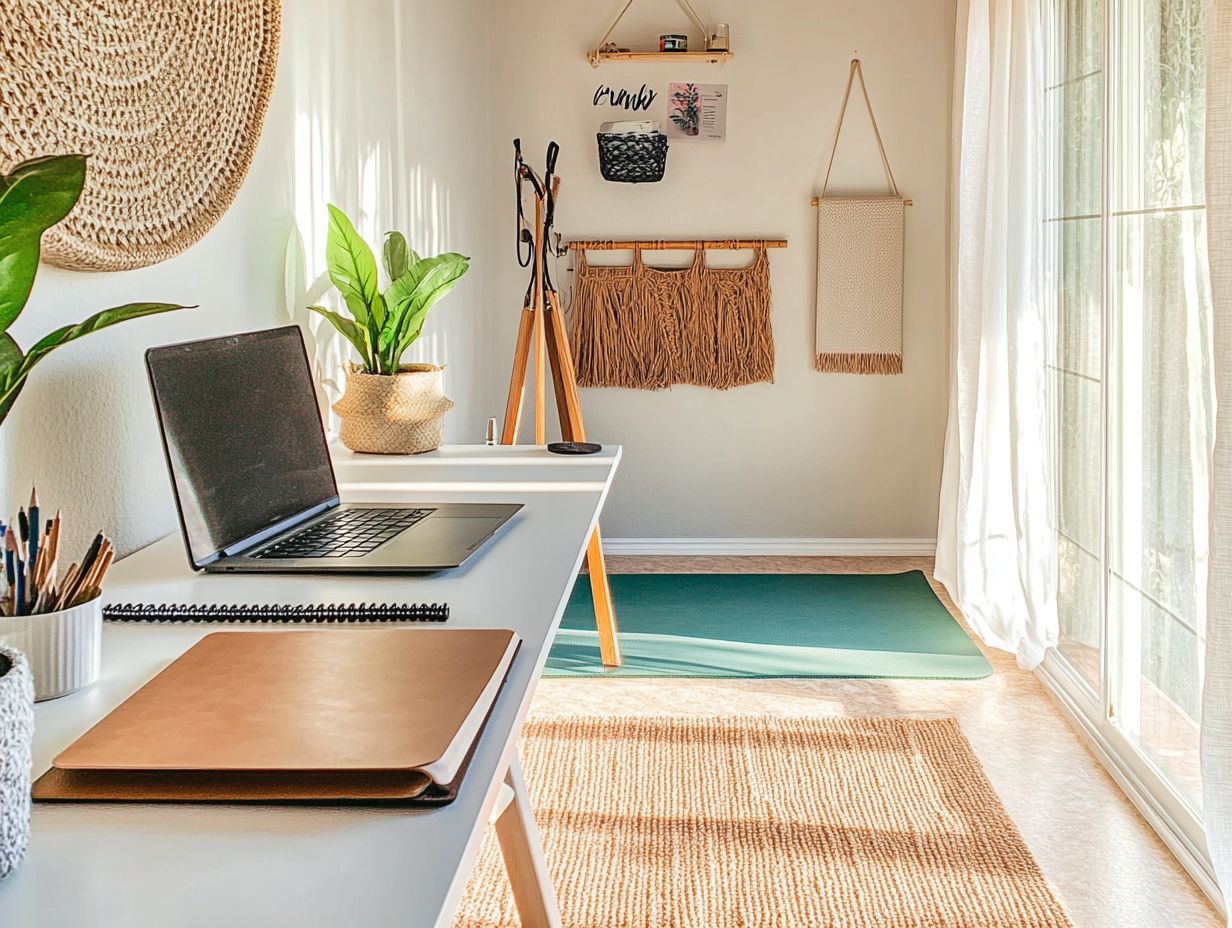How to Create a Training-Friendly Home Environment
Creating a training-friendly home environment can profoundly elevate your success, whether you’re focused on personal development, fitness goals, or skill-building.
This article provides valuable insights on crafting a dedicated training space that minimizes distractions, equipping it with essential tools, and establishing a consistent routine.
Discover how to seamlessly integrate training into your daily life, cultivate a positive atmosphere that fosters motivation, and effectively address the challenges you encounter along the way.
Get ready to transform your home into an amazing training hub that inspires and motivates!
Contents
- Key Takeaways:
- Setting Up Your Home for Training Success
- Designing a Dedicated Training Space
- Essential Equipment and Tools
- Establishing a Routine
- Incorporating Training into Daily Activities
- Maintaining a Positive Atmosphere
- Dealing with Challenges and Setbacks
- Frequently Asked Questions
- What is a training-friendly home environment?
- What are some ways to maintain an organized training-friendly home environment?
- How can I minimize distractions in my home environment for training?
- What resources should I have readily available for a training-friendly home environment?
- How can I make my home environment comfortable for training?
- What are some common mistakes to avoid when creating a training-friendly home environment?
Key Takeaways:

- A dedicated training space can improve focus and minimize distractions.
- Incorporating training into daily activities makes it a seamless part of your routine.
- Maintaining a positive atmosphere can make training fun and rewarding.
Setting Up Your Home for Training Success
Creating an effective home learning environment is crucial for your child’s success, providing a nurturing space where they can thrive through engaging and educational experiences. This setup should seamlessly weave in elements of learning through play (play-based learning), ensuring that every corner of your home becomes a tool for discovery while promoting emotional and social skill development.
A well-structured environment benefits not just your child but also boosts family engagement, enabling you to guide your little one in their journey of independent learning and exploration.
Benefits of a Training-Friendly Home Environment
A training-friendly home environment brings numerous benefits for your children. It enhances their emotional and social skills during formative years.
This type of space encourages learning through play, promoting collaboration and problem-solving with peers and family.
For instance, creating a designated play area brimming with educational toys can spark imaginative play, where your children can practice sharing, taking turns, and expressing their feelings in a safe space.
Engaging in family activities like cooking together fosters teamwork and boosts communication skills, as they learn to articulate their thoughts and needs. This can also include reading together to enhance their overall learning environment.
This nurturing atmosphere helps your children build resilience and empathy, laying a solid groundwork for successful social interactions in their future.
Designing a Dedicated Training Space
Creating a dedicated training space in your home is essential for fostering focused, structured play and enriching learning experiences for your children. This space should be equipped with creative materials that spark curiosity:
- Art supplies
- A variety of books
- Educational games that promote open-ended play
By implementing a toy rotation system, you can maintain a fresh and stimulating environment, which will enhance your child’s motivation to explore and learn.
Creating a Distraction-Free Area
Creating a distraction-free zone for training is essential to maximize focus and elevate your child’s learning experience, enabling them to develop vital emotional and communication skills necessary for their independent learning journey.
By minimizing distractions, you can cultivate an environment where your child can fully immerse themselves in their activities without external interruptions. Regular safety checks will ensure that the training area is free from hazards, granting you peace of mind.
Organizing the space for optimal concentration can significantly enhance your child’s ability to absorb lessons. This includes:
- Removing clutter
- Utilizing soft lighting
- Incorporating calming colors to stabilize mood
Designating specific zones for different activities can facilitate smooth transitions for your child, reinforcing their focus and promoting a consistent learning rhythm.
Essential Equipment and Tools

Having the right equipment and tools is essential for creating a training-friendly home environment. These elements can greatly enhance play-based learning and spark creativity.
A well-arranged space invites exploration. It’s crucial to include colorful educational games that stimulate critical thinking and problem-solving skills, which are vital for early childhood development.
Incorporating creative materials like art supplies allows children to express themselves, nurturing their imagination and helping develop their fine motor skills, or the ability to use small muscles in their hands.
Soft seating options provide comfort, allowing young learners to settle in for longer sessions. Clever storage solutions keep everything organized and accessible. Together, these components foster a nurturing atmosphere, enhancing the overall learning experience and making it enjoyable for children.
Establishing a Routine
Establishing a routine is vital for successful training and learning. It provides the consistency needed for emotional stability and aids in developing social skills in children.
By creating a structured environment with a designated learning space, you enable children to thrive both academically and personally.
Consistency and Structure for Successful Training
Consistency and structure help children grasp expectations and cultivate emotional and social skills.
When children understand what s expected of them, they thrive in a secure environment that nurtures growth. Implementing a predictable daily routine significantly enhances their ability to focus and engage in various tasks.
You can elevate training outcomes by incorporating practical strategies. Designating specific times for homework, structured play, and family interactions boosts family engagement. Establishing clear and consistent rules, along with rewards, reinforces positive behavior and makes navigating social situations easier for children.
An organized physical space, free from distractions, creates a productive atmosphere for learning and emotional development.
Incorporating Training into Daily Activities

Incorporating training into daily activities like reading or sharing play ideas not only makes learning enjoyable but also reinforces the importance of emotional and social skills.
Engaging in practical experiences that foster family involvement creates a rich environment for growth and development.
Ways to Integrate Training into Daily Tasks
Integrating training into daily tasks can be seamless. It allows you to harness everyday learning opportunities that enhance a child-friendly environment and promote open-ended play.
By incorporating educational moments into routine activities like cooking, reading together, or shopping you can turn mundane chores into engaging experiences. For example, while preparing meals, involve your children in measuring ingredients, discussing nutritional values, or even creating a menu. This approach not only teaches them math and science but also fosters creativity.
During grocery shopping, encourage your children to identify colors, shapes, and prices, transforming the errand into an interactive learning session. These small yet impactful strategies cultivate a rich child-friendly environment filled with exploration and curiosity, ensuring every moment is a valuable opportunity for meaningful development.
Maintaining a Positive Atmosphere
A positive atmosphere is key to effective training! It creates a supportive place for learning where children feel encouraged and motivated to explore new concepts and skills.
This nurturing approach not only fosters their curiosity but also enhances their willingness to engage and absorb new information, further promoting their emotional skills.
Encouragement and Motivation for Effective Training
Encouragement and motivation are essential in effective training. They help children develop emotional skills and enhance family engagement in their learning journey.
Creating an environment where children feel safe to express themselves can significantly boost their confidence. For example, incorporating cardboard boxes for creative play can be beneficial.
You might consider setting achievable goals or offering constructive feedback. This not only helps children track their progress but also nurtures a sense of accomplishment.
Make training fun to spark excitement and enthusiasm. This transforms challenging tasks into rewarding experiences.
Involving the whole family in these activities fosters teamwork, respect, and understanding key emotional skills vital for social development.
Ultimately, a supportive atmosphere built on encouragement can pave the way for lifelong learning, foster home culture, and promote resilience.
Dealing with Challenges and Setbacks
Navigating challenges and setbacks is an inherent aspect of the learning journey. Grasping how to maneuver through these obstacles enables parents to cultivate emotional skills and resilience in their children.
Strategies for Overcoming Obstacles
Implementing effective strategies to overcome obstacles can significantly enhance a child’s emotional skills. It creates a more robust learning environment for them.
By fostering an atmosphere that encourages resilience, you can support your child in developing self-confidence and greater emotional intelligence.
This might involve creating a regular schedule, which provides them with a sense of security and prepares them to face challenges with a positive mindset.
Teaching your child to identify and express their emotions boosts their ability to navigate academic hurdles. Engaging in open conversations about feelings equips them with tools for stress management, enabling them to confront difficulties head-on.
Ultimately, this leads to improved academic performance and a more fulfilling educational journey for your child.
Frequently Asked Questions
What is a training-friendly home environment?

A training-friendly home environment is a space that is conducive to learning and practicing new skills. Creating such an atmosphere can also include how to train your pet for a calmer home, emphasizing family engagement to support early childhood development.
Factors include organization, minimal distractions, and resources readily available for training activities.
What are some ways to maintain an organized training-friendly home environment?
One way is to designate a specific area in your home for training activities, such as a designated learning space. For more effective strategies, consider these tips for training anxious pets at home. This could be a spare room or a corner in a room that is free from clutter.
Regularly decluttering and organizing your training materials, including books and art supplies, helps keep the space tidy.
How can I minimize distractions in my home environment for training?
Choose a quiet area for training, away from high-traffic areas or noisy household appliances. Communicate with other members of your household, including home visitors, to request quiet during designated training times.
What resources should I have readily available for a training-friendly home environment?
Essential resources include training materials like books or videos, as well as any necessary equipment or tools. Having a designated space for note-taking and organizing materials is also helpful.
How can I make my home environment comfortable for training?
Ensure the training area has adequate lighting, comfortable seating, and proper ventilation. You can add personal touches, such as motivational posters or calming music, to create a welcoming environment.
What are some common mistakes to avoid when creating a training-friendly home environment?
Avoid choosing a crowded or cramped space, as this can be distracting. Don’t forget to steer clear of isolated areas, which can lead to feelings of loneliness and lack of motivation. Instead, create a child-friendly environment that encourages learning and effective communication.
Avoid these common pitfalls to ensure successful training!
Ready to transform your home into a training haven?






